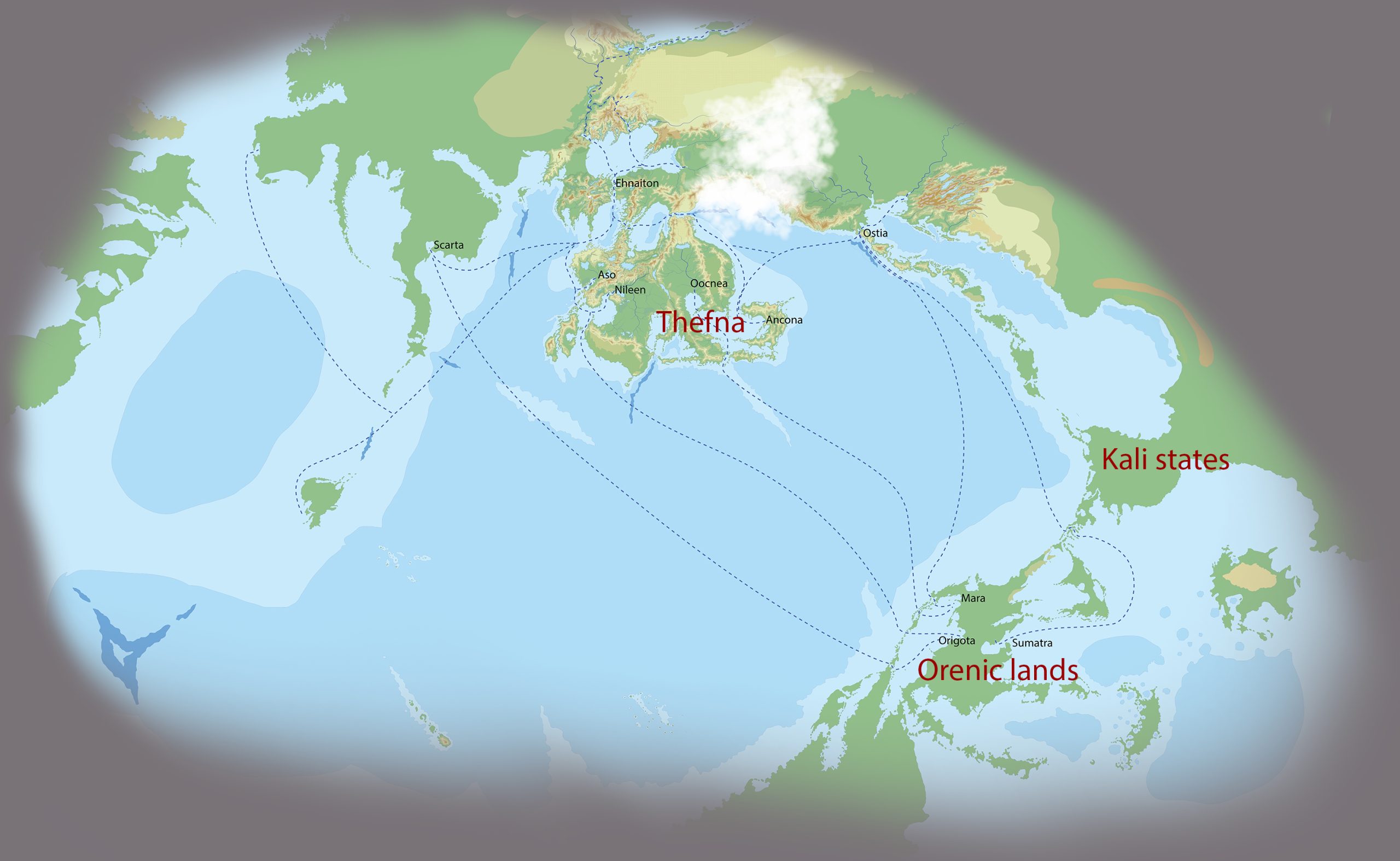Today we’re going to zoom out and think about the reasons for the decline of the Still Unnamed City (which may or may not become its official name).
In order to make it easier to write about the city’s history, I will give the city a nickname… Iron Gate. Iron, because the city’s fame, power, and wealth came from mediating iron from the asteanic merchants to the rest of the Kali states, and Gate, because the city was the only gate to the rest of the Kali states.
The story of the city’s power began seven centuries ago when asteanic seafarers and merchants were looking for a way to Oreenia during their coastal voyages. Since there were no ships at the time that could withstand the sea voyage directly across the great ocean from Thefna (the homeland of the asteanic civilization) to Oreenia, the ships sailed along the coast of the eastern islands.
Many of the islands encountered along the way became asteanic colonies, and bad things happened to their people. However, the Kali states and cities were large and powerful, and conquering them would have been beyond the asteanic capabilities. Especially when the goal was to reach Oreenia, where different groups of merchants and adventurers were already conducting conquest wars against the local states.
The leader of the Itza clan, Tzeki, was at war with the neighboring tribes at that time and made an alliance with the asteans – the asteans offered him iron and tin (necessary for making bronze) and he offered the sailors a safe place to stay and food during their long sea journey to Oreenia.
Within a couple of decades, with the help of the asteanic iron, Tzeki conquered the surrounding islands and the city of Iron Gate, and the kingdom of the Itzas grew into a powerful Kali kingdom. Over the following centuries, the Itza kingdom monopolized all sea travel and trade in the surrounding islands – even the asteanic emperors sent tributes to the Itza kings so that they would not attack asteanic merchants.
Several hundred years ago, when the junk-type ship was developed, which was suitable for crossing the ocean directly, merchants had less and less reason to visit the arrogant and greedy Iron Kings of Itza. The main trade routes between north and south now went directly across the ocean. This of course did not mean that the state of Itza would immediately decline. There were still merchants who wanted to do business with them and the king himself had a formidable naval fleet, with which he controlled all the surrounding archipelagos and demanded tribute from continental states.
The reason for the decline of the maritime state of Itza’s is actually the long reign of Tzek III the Stubborn, the father of today’s king Wadcha VII Itza, combined with the growth of the power of the continental state of Zipopan.

The city-state of Zipopan had, over decades of wars, annexed a large number of smaller city-states and grown to become the largest state on the continent. Throughout this time, they had faithfully paid tribute to the kingdom of Itza and thus the rulers of Itza had no reason to intervene in the situation. However, at the beginning of Tzek III’s reign, the Zipopans stopped paying tribute and a war began, which lasted throughout Tzek III’s reign, almost 30 years.
The first decade of the war is characterized by relatively low military activity: Zipopani did not have a navy to directly attack the kingdom of Itza and the Itzas mainly carried out raids on the continent rather than conquest expeditions. The goal was to force the Zipopans to pay tribute, not to conquer their state.
When this led to nowhere, Tzek III changed his strategy and in 1481. began a campaign on the continent with the goal of conquering Zipopani. The bloody campaign lasted over ten years and caused famine and disease that killed hundreds of thousands if not millions of Kalis. The entire wealth of the Itza state went to arming, equipping, and paying the wages to all sorts of orenic, asteanic and roadic mercenaries – without any result.
In 1492, Tzek III had to retreat from the continent. This was followed by a period of recovery, which the Zipopans used to build their navy and in 1497, they destroyed the Itza state navy completely in sea battles. Today, 15 years have passed since those battles and there are many Kalis living in the city and around it who remember all this well.
Because of the loss of the navy and because the kingdom never had a centralized structure, the state of Itza collapsed. The kingdom consisted of hundreds of Kali and Orenic tribes, all of which were connected to the king through some type of vassal agreement, under which they had to pay taxes and come to the war. The guarantee of these agreements was the Itza’s extremely powerful navy, which quickly and effectively suppressed any resistance. However, without a navy, the tribes had no reason to continue paying tribute.
When Wadcha VII Itza came to power in 1499, he inherited a state that essentially consisted of only the Iron Gate city and its surrounding villages from his father. He has been clinging to it with all his might since then.



























Leave a Reply